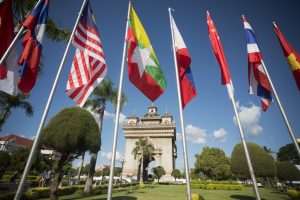Laos took over the presidency of ASEAN in January and already faces its first major test. How will it approach the issues — tensions in the South China Sea, escalating problems in Myanmar, and the growing rivalry in the Pacific between the United States and China — that its predecessor, Indonesia, was unable to fully address?
As the most economically disadvantaged and smallest member state of ASEAN, with a population of just 7 million, Laos faces the daunting responsibility of ensuring ASEAN’s continued relevance amid not only its own domestic economic challenges but also international pressures. This raises doubts about Laos’ capacity to lead the struggling regional organization.
The 50-year Commemorative Summit between ASEAN and Australia, which started on March 4, could give a clue as to how Vientiane will tackle maintaining ASEAN’s central role in the region. The talks will mark the historical roots of the Australia-ASEAN relationship, which date back to 1974 when Australia became ASEAN’s Dialogue Partner.
Canberra’s commitment to enhancing ASEAN-Australia dialogue relations was evidenced by its accession to the Treaty of Amity and Cooperation (TAC) in 2005 and the establishment of the Australian Mission to ASEAN in 2013. During the ASEAN-Australia 40 Years Summit in 2014, leaders proclaimed the elevation of ASEAN-Australia dialogue relations to a strategic level.
At its core, the primary obstacle to ASEAN’s relevance lies in the threat to its centrality, a position the bloc must uphold. The conception of centrality is constantly defended against the encroachment of outside powers, particularly in light of the China-U.S. competition over the past 10 years.
China’s rise prompted then-U.S. President Barack Obama’s pivot to Asia in 2011. While Obama pursued a policy of re-engagement, his successor flipped that upside down. Donald Trump implemented aggressive tactics with his America First policy and initiated a trade war with China.
After Trump’s defeat in 2020, current President Joe Biden continued this trend by establishing security-focused partnerships such as the Quadrilateral Security Dialogue (Quad) and the security deal between Australia, United Kingdom, and United States (AUKUS) to circle China.
Since ASEAN’s core principles of centrality conflict with the exclusive nature of minilateralism that focuses only on small, specific like-minded states, U.S. security-focused minilateralism undermines and poses risks to ASEAN centrality.
Laos and Australia find themselves in conflicting positions amid the current geopolitical rivalry.
Laos has become highly dependent on China due to its economic ties. Exacerbated by COVID-19, Laos’ total debt exposure to China reached an alarming 64.8 percent of total GDP in 2022, making Laos susceptible to Chinese influence.
Australia has consistently aligned with the United States and is a participant in Quad and AUKUS. Australia’s decision to engage in strategic cooperation with the U.S. is motivated by its identity as a democratic state, a proponent of liberal values, and a member of the “Anglosphere.” For the last decade Australian leaders have expressed growing concerns about Chinese President Xi Jinping’s increasingly authoritarian approach, leading to a shift in bilateral relations from a “cooperative partnership” to a “competitive rivalry.”
The contrast between Laos and Australia’s positions poses a challenge to Vientiane’s leadership capability. The question is whether Vientiane can bridge this gap with Canberra.
Geopolitically, ASEAN functions as a viable hedging strategy, offering Australia substantial benefits derived from its association with the region. On paper, Canberra is poised to demonstrate its commitment to ASEAN Centrality.
The plan of action to implement the ASEAN-Australia Strategic Partnership (2020-2024) reaffirms the priority of shaping a peaceful, prosperous, and rules-based region with ASEAN at its center.
During the first ASEAN Australia Summit in 2021, both parties agreed to establish an ASEAN-Australia Comprehensive Strategic Partnership (CSP), reflecting their mutual commitment to ASEAN centrality, the promotion of regional rules, and support for the ASEAN-led regional architecture.
Despite the Quad Indo-Pacific Strategy, Australia has reassured its ASEAN counterparts by adopting the Joint Statement of the Second Annual ASEAN-Australia Summit on Cooperation on the ASEAN Outlook on the Indo-Pacific (AOIP) in 2022.
That means the success of Laos’ presidency in maintaining ASEAN’s centrality hinges on the country’s determination to counter Chinese influences. It has done so before. Despite being the smallest country, Laos effectively managed Chinese demands during its presidency in 2016. So there is hope.
Vientiane has underscored its foreign policy focus on peace, independence, friendship, and cooperation. It acknowledges the crucial role of ASEAN as the primary platform to publicize its foreign policy. Under its ASEAN Presidency in 2024, Laos has prioritized the theme of “Enhancing Connectivity and Resilience,” emphasizing the need to bolster resilience to uphold ASEAN centrality and sustain its relevance.
For the time being, Laos’ presidency can serve to bridge differences by playing up the steadfast commitment to ASEAN centrality from all stakeholders. Progress can be achieved with Australia by prioritizing non-security cooperation through the Aus4ASEAN Initiatives.
Anthony Albanese’s visit to China — the first by an Australian prime minister since 2016 — sent a favorable message that Australia is eager to improve ties with China, relieving pressure on Laos to close the gap.
However, a shift is anticipated by the end of the year, particularly after the U.S. presidential election and the possibility of the adoption of a new security posture in the Indo-Pacific.
Therefore, Laos must tread carefully in its relations with China and maximize the remaining time to garner collective support for ASEAN centrality.
Originally published under Creative Commons by 360info™.

































